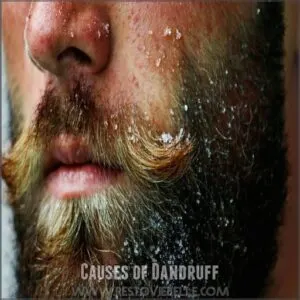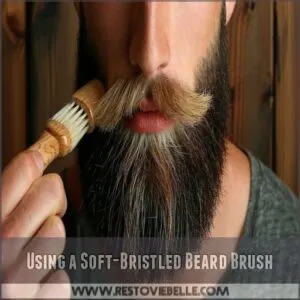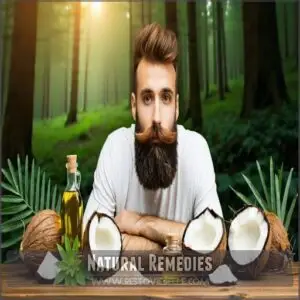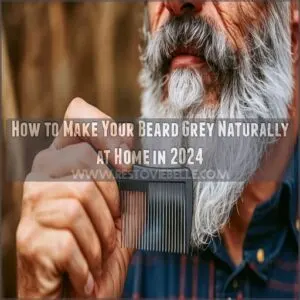This site is supported by our readers. We may earn a commission, at no cost to you, if you purchase through links.
 Tired of those pesky white flakes raining down from your beard? You’re not alone.
Tired of those pesky white flakes raining down from your beard? You’re not alone.
To get rid of beard dandruff, start with gentle daily cleansing using a mild beard wash.
Keep your skin moisturized with beard oil – think of it as a drink of water for your facial hair.
Regular exfoliation with a soft-bristled brush helps sweep away dead skin cells, while natural remedies like coconut oil and tea tree oil can work wonders.
If you’re still seeing snowflakes in summer, your beard might be telling you something deeper’s going on – from sneaky fungal issues to stress-related triggers that need a different approach.
Table Of Contents
- Key Takeaways
- What is Beard Dandruff
- Get Rid of Beard Dandruff
- Causes of Dandruff
- Signs of Beard Dandruff
- Washing Beard for Dandruff
- Using Beard Oil
- Exfoliating The Beard
- Natural Remedies
- Preventing Dandruff
- Managing Severe Dandruff
- Frequently Asked Questions (FAQs)
- How to get rid of dandruff with Beard oil?
- How do you get rid of dandruff?
- What is the best treatment for Beard dandruff?
- How to get rid of dandruff with a beard brush?
- Does beard balm get rid of dandruff?
- Does trimming a beard help dandruff?
- How do I stop dandruff on my beard?
- Will beard dandruff go away if I shave?
- Why do I get dandruff when I scratch my beard?
- What causes facial dandruff?
- Conclusion
Key Takeaways
- Keep your beard clean and moisturized by using a mild beard wash daily and applying beard oil – look for products with jojoba or coconut oil to combat dryness and flaking.
- Exfoliate gently with a soft-bristled brush before washing to remove dead skin cells and ensure your cleansing products reach the skin underneath your beard.
- If over-the-counter treatments aren’t working, you might have an underlying condition like seborrheic dermatitis or psoriasis – consult a dermatologist for proper diagnosis and treatment.
- Don’t forget the basics – stay hydrated, eat a balanced diet rich in vitamins A, C, E and omega-3s, and manage your stress levels to prevent beard dandruff from returning.
What is Beard Dandruff
You know those annoying white flakes you sometimes see in your beard? That’s beard dandruff, a common issue that can make your beard itchy and look a little unkempt.
Dry and Itchy Skin
That dry, itchy beard skin? It’s like a desert down there.
Itchy patches and dry flakes pop up when your beard skin is thirsty for moisture.
This can lead to skin irritation, especially if your skin is sensitive, making beard dandruff a real pain.
Regular beard skin care, like moisturizing and gentle exfoliation, offers beard soothing and skin relief, taming that itchy beard and dry beard.
White Flakes and Shedding Skin
Those pesky white flakes aren’t snowflakes, but signs of dry, irritated skin shedding in your beard. Itchy patches and beard dandruff can make your beard look messy. Getting rid of beardruff isn’t hard—gentle washing and moisturizing are your secret weapons.
- Beard dandruff can make you feel self-conscious.
- White scales are a common sign of beardruff.
- Skin flakes can be itchy and irritating.
- Dry skin remedies can help prevent beardruff.
- Flake prevention starts with a good beard care routine.
Causes and Risk Factors
Beard dandruff’s causes can be surprising. Skin dryness, yeast overgrowth (Malassezia), and harsh products can trigger it. Even stress and poor grooming play a role.
Here’s the breakdown: Understanding beard care tips is essential to tackle the root causes.
- Seborrheic dermatitis (skin condition)
- Malassezia yeast (fungal infection)
- Genetic predisposition
- Environmental factors (dry air)
These beardruff causes can turn your beard into a flaky mess. Don’t let them win!
Get Rid of Beard Dandruff
Fighting that pesky beard dandruff? You’ve got this! Your first line of defense? Gentle cleansing. Think of your beard as a prized garden – you need the right tools. A beard-specific shampoo with ketoconazole or zinc pyrithione is your magic potion for banishing those flakes. Treat your skin underneath with the same TLC.
Next up: moisturizing. Don’t let dryness set up shop. A good beard oil, like one with jojoba or coconut oil, is like a soothing drink for your skin. It’s key for beard health and dandruff remedies.
Exfoliation is your secret weapon for removing dead skin – the source of those annoying flakes. A soft brush will do the trick. Regular exfoliation paves the way for a healthy, flake-free beard.
Natural remedies can also join the fight. Tea tree oil or apple cider vinegar can offer extra dandruff-busting power. Remember, consistency is key for long-term beardruff treatment and removal. Keep up your routine, and you’ll be saying goodbye to flakes and hello to a healthy, happy beard. This is beard maintenance and skin care at its finest!
Causes of Dandruff
You’re not alone if you’ve noticed those pesky white flakes in your beard; several things can cause beard dandruff, from simple dry skin to a bit of a yeast party happening in your facial hair.
Let’s break down the common culprits so you can get your beard back to its majestic, flake-free glory.
Dry Skin and Lack of Moisture
So, your beard feels like a Brillo pad? That’s dry skin screaming for moisture. Skin hydration is key.
When your beard’s moisture balance is off, it leads to dry patches, a dry beard, and ultimately, beard dandruff. Think of it like a desert – thirsty and flaky.
- Combat dry skin with a good beard moisturizer.
- Boost beard hydration with proper beard care.
- Regular flake removal keeps your beard looking its best.
Fungal and Yeast Infections
Dry skin isn’t just uncomfortable; it’s an open invitation for a yeast infection.
Malassezia thrives in your beard’s warm, damp microclimate, causing beard dandruff.
Antifungal treatments, especially ketoconazole shampoo, offer effective yeast control and restore microbial balance.
To learn more about beard dandruff treatment, understanding the causes and symptoms of the condition is helpful.
| Yeast Infection | Fungal Overgrowth | Skin Infections |
|---|---|---|
| Itchy beard | Flaky skin | Redness |
| White flakes | Irritation | Inflammation |
| Malassezia globosa | Pityrosporum ovale | Microbial imbalance |
| Ketoconazole shampoo | Antifungal treatments | Beard dandruff |
Seborrheic Dermatitis and Psoriasis
Yeast isn’t the only culprit behind beard dandruff. Seborrheic dermatitis and psoriasis can also cause those pesky flakes.
Here’s the lowdown:
- Seborrheic dermatitis: Think red, scaly patches.
- Psoriasis: Similar to seborrheic dermatitis, but often thicker scales.
- Both can make your beard itchy and uncomfortable.
- They’re different from regular beardruff, so see a dermatologist if you’re unsure.
- Treating these conditions can help you finally conquer beard dandruff.
Oily Skin and Fast Cell Turnover
Beyond psoriasis, oily skin and speedy cell regeneration can also trigger beard dandruff.
Excess oil creates a playground for Malassezia fungus, throwing your skin’s pH balance out of whack.
This can lead to a flurry of flakes – more snowstorm than stylish beard, and seborrheic dermatitis can be managed by maintaining good facial hygiene.
Managing oil production and maintaining good facial hygiene are key to controlling seborrheic dermatitis and keeping beardruff at bay.
Signs of Beard Dandruff
You’ll want to know what to look for if you think you might’ve beard dandruff.
Itchy, flaky skin under your beard is the main symptom, but you might also notice redness or greasy patches.
Visible White Flakes
White flakes in your beard aren’t just annoying—they’re a confidence killer. These beard flakes, often caused by dry scaling or yeast buildup, result from a lack of proper care. When shedding skin turns into visible white patches, it’s time to act.
Here’s where flakes come from:
- Skin irritation from dryness or harsh products
- Yeast overgrowth leading to rapid cell turnover
- Poor beard care routines causing buildup
Focus on flake removal and treating beard dandruff to get rid of beardruff fast.
Redness and Itching
Red, irritated skin and an itchy beard can make beard care feel like a losing battle.
When beard inflammation hits, it’s your skin’s SOS. Stress, dry patches, and sensitive skin are common beardruff causes.
Hydrate with beard oil, ease itching with gentle products, and opt for a balanced diet—your beard will thank you for the TLC!
Greasy Patches and Crust
If you’ve noticed greasy flakes, crusty buildup, or oily residue around your beard, it’s not just messy—it’s a sign of beard dandruff.
Greasy skin often stems from seborrheic dermatitis, leaving yellowish scales that scream for better care.
Use gentle exfoliation and shampoos designed to remove beard dandruff and tame beard crust for a healthier, cleaner look.
Washing Beard for Dandruff
Washing your beard properly is one of the easiest ways to tackle dandruff and keep your skin healthy.
Use a gentle cleanser, avoid scorching hot water, and always focus on cleaning the skin underneath.
Choosing a Suitable Cleanser
Picking the right beard cleanser is like finding the perfect wingman—it’s gotta work with your skin, not against it. Look for gentle formulas with ingredients like ketoconazole or zinc pyrithione, designed for your specific skin type.
A pH-balanced, fragrance-free antidandruff beard wash is gold for tackling flakes without irritating skin. These beardruff shampoos maintain natural oils, keeping your beard shampoo routine effective without stripping away that much-needed moisture.
Using a beard dandruff shampoo can be an effective way to manage and prevent beard dandruff.
Avoiding Harsh Chemicals and Hot Water
When washing your beard, think softly. Gentle cleansers and chemical-free products protect your skin’s moisture without causing irritation.
Scalding hot water might feel satisfying, but it strips away natural oils, making your beardruff worse. Stick to lukewarm or soft water to keep your skin happy and flake-free.
Try mild shampoos or natural soaps designed for sensitive skin—your beard will thank you with less itch and way fewer flakes.
Massaging The Shampoo Into Skin
Ever wonder why your beard dandruff won’t budge? It’s all about shampoo techniques and massaging the skin beneath your beard. Follow this routine:
- Start with a dry, product-free beard.
- Apply beard shampoo directly to your fingertips.
- Massage your skin with gentle, circular motions to encourage scalp stimulation.
- Focus on those patchy, flaky areas while avoiding harsh scrubbing.
- Rinse thoroughly, leaving no residue behind.
Understanding the beard shampoo difference is essential for effective beard care.
Consistent gentle cleansing and beard massage can do wonders!
Using Beard Oil
Beard oil isn’t just for making your beard look shiny—it’s also a game-changer for fighting dandruff.
By keeping the skin underneath moisturized, it helps stop those annoying flakes before they show up.
Benefits of Jojoba and Coconut Oil
Got beard dandruff? Jojoba and coconut oils are game-changers for beard health.
Packed with vitamins, they boost skin moisture, calm itchiness, and stop flakes in their tracks.
Plus, they’re natural remedies with antifungal powers and help with hair growth.
Use them for soft, healthy facial hair that feels great and flaunts zero dandruff—your beard will love it!
How to Apply Beard Oil
Tired of beard dandruff hijacking your look? Nail your beard care routine with these oil application tips:
- Start fresh: wash your beard, then towel-dry gently.
- Rub 3-6 drops of beard oil between your palms to warm it up.
- Use gentle massage techniques to work the oil into your skin—where dandruff lurks.
- Spread evenly through your beard for proper hydration and skin moisturizing.
- Comb your beard to keep things smooth and prevent greasy patches.
It’s all about taming flakes and owning your beard hygiene!
Choosing The Right Beard Oil
Picking the right beard oil is key to handling beard dandruff and keeping that beardruff under control.
Here’s a cheat sheet:
| Oil Type | Benefits | Best For |
|---|---|---|
| Jojoba | Moisturizes | Dry, flaky skin |
| Coconut | Anti-fungal | Dandruff control |
| Argan | Softens hair | Coarse textures |
Using coconut beard products can help alleviate dandruff symptoms.
Choose oils with natural ingredients to boost your beard care routine.
Exfoliating The Beard
Exfoliating your beard helps remove dead skin cells and keeps your beard looking healthy and flake-free.
Using a soft-bristled brush before washing can also boost your results by clearing out buildup hiding under the hair.
Using a Soft-Bristled Beard Brush
A soft-bristled beard brush, like a boar bristle option, is a beard care essential. It evenly distributes natural oils, removes trapped flakes, and boosts overall beard grooming.
Use light, sweeping strokes to avoid irritation while maximizing benefits. Want a smoother look and itch-free skin? Get brushing—daily grooming with the right technique transforms your beard maintenance game.
Investing in a beard brush tool can make a significant difference in your beard care routine. Your face will love it!
Exfoliating Regularly to Remove Dead Cells
Beard exfoliation is a game-changer for dealing with beard dandruff. A gentle scrub with a soft-bristled brush 1-2 times weekly removes dead skin, encourages cell renewal, and smooths your skin while keeping flakes at bay.
- Choose a soft-bristled brush.
- Massage gently in circular motions.
- Target areas prone to flaking.
- Avoid over-scrubbing.
- Follow up with beard oil.
Exfoliating Before Washing for Better Results
Before grabbing your beard wash, start with beard exfoliation using a soft-bristled brush. This pre-wash routine clears stubborn flakes and dead skin while prepping your face for an effective wash.
Gentle scrubbing stimulates circulation, letting the cleanser reach deep. Exfoliant tools, like brushes or scrubs, make skin preparation simple—just remember, don’t overdo it; a light touch works best!
Understanding beard acne causes can also help you develop a more effective skincare routine to prevent beard dandruff and other issues.
Natural Remedies
Natural remedies can work wonders for beard dandruff without exposing your skin to harsh chemicals.
From coconut oil to tea tree oil, these simple solutions are easy to try and surprisingly effective.
Coconut Oil and Apple Cider Vinegar
When beard dandruff strikes, turn to natural remedies like coconut oil and apple cider vinegar.
Coconut oil deeply hydrates, while vinegar’s acidity fights flakes by balancing your skin’s pH.
Mix equal parts, massage it into your beard, and let it sit for 10 minutes.
This combo acts as a skin soother and beard nourisher, leaving your beard looking healthy and flake-free.
Tea Tree Oil and Baking Soda
Got flaky skin driving you nuts?
Tea tree oil is a go-to fungal fighter! Mix a few drops with baking soda for a DIY exfoliant that tackles dead skin and soothes irritation.
But easy does it—this potent oil isn’t for full-strength use. Start small, test on a patch, and watch your beardruff disappear like magic!
Fish Oil Supplements and Dietary Changes
Beyond topical treatments, consider tweaking your diet and adding fish oil supplements. These supplements, packed with omega fatty acids, can help reduce beard dandruff by tackling inflammation from within.
Dietary adjustments, like upping your intake of foods rich in omega-3s, provide similar fish oil benefits and improve overall nutrition. Proper nutrition planning, including getting enough vitamins and minerals, supports a healthy beard and reduces those pesky flakes.
Understanding the fish oil benefits can also play a significant role in promoting overall hair and scalp health. Need supplement guidance? Chat with your doctor about incorporating fish oil into your routine.
Preventing Dandruff
You can prevent beard dandruff by keeping your skin healthy with simple habits like staying hydrated and eating a balanced diet.
Getting enough sleep and managing stress aren’t just good for your mood—they help keep those pesky flakes away too, with simple habits.
Eating a Balanced Diet Rich in Nutrients
A healthy beard starts with nutrient-packed meals. Focus on vitamins A, C, E, zinc, and omega-3s. Snack on foods like salmon, avocados, or walnuts.
Balanced meals with fresh produce and healthy fats keep skin nourished. Don’t skip hydration—water helps prevent flaky skin too.
Struggling? Consider dietary supplements to fill the gaps and boost your beard health benefits effortlessly!
Prioritizing Sleep and Reducing Stress
Good nutrition fuels your body, but managing stress is like giving your beard a spa day. Poor sleep and stress can inflame your skin and wreck your beard’s vibe.
Tame that stress monster and improve your sleep patterns for healthier skin and exceptional beard care. Understanding the dandruff vs dry scalp differences is essential for effective treatment.
Try these simple yet effective relaxation techniques:
- Schedule your sleep like an important meeting.
- Wind down with mindful meditation or calming exercises.
- Deep breathing is your secret weapon against stress – use it!
Staying Hydrated and Managing Stress
Managing beard dandruff starts with smart hydration tips and stress reduction.
Water is your skin’s natural moisturizer, so hit that goal of 8 glasses a day.
Feeling fancy? Try infused water or herbal teas.
Stress wreaks havoc on skin care, so lean into healthy habits like yoga, meditation, or a good nature walk.
Can’t sit still? Journaling or mindful breathing works wonders too.
Keep toxins at bay by hydrating, and if stress wins, it’s your beard that pays.
Hydrated, chilled-out living equals better beard health.
Managing Severe Dandruff
When beard dandruff gets out of hand and home remedies stop working, it’s time to explore other options.
Seeing a dermatologist can help you figure out if conditions like psoriasis or eczema might be the real culprits.
If Home Remedies Are Ineffective
When DIY fixes fail to treat beard dandruff, it’s time to seek professional advice.
A dermatologist can provide a custom game plan to remove beard dandruff for good. They might suggest:
- Prescription antidandruff shampoos or medicated beard shampoos.
- Medical treatments like antifungal creams or lotions.
- Participation in clinical trials for advanced solutions.
- A complete skin review to rule out misdiagnosis.
Don’t let beard dandruff win—professional help works wonders!
Underlying Medical Conditions
Sometimes beard dandruff isn’t just from dryness or fungal issues—it could stem from deeper medical triggers. Conditions like seborrheic dermatitis, psoriasis, eczema, or even hormonal imbalances might be to blame. Skin infections or Malassezia yeast overgrowth also sneak in as culprits, leaving behind redness, itching, and flakes you can’t ignore.
A quick chat with a dermatologist can help uncover these hidden causes, saving you from endless trial and error.
Here’s a breakdown of potential medical triggers:
| Medical Trigger | Common Symptoms | Health Impacts |
|---|---|---|
| Seborrheic Dermatitis | Red, greasy patches | Frequent recurrence |
| Psoriasis | Thick, scaly plaques | Autoimmune complications |
| Eczema | Intense itching, dryness | Ongoing inflammation |
| Hormonal Imbalance | Flakes, hair thinning | Worsened skin health |
Ruling Out Psoriasis and Eczema
That stubborn beard dandruff might actually be psoriasis or eczema in disguise. Here’s what to look for:
- Silvery-white, scaly patches that stick around longer than typical dandruff
- Red, inflamed skin that feels warm to touch
- Dry, cracked areas that might sting or burn
- Patches that worsen with stress or weather changes
- Flaking that spreads beyond your beard area
If you spot these signs, skip the dandruff shampoo and head straight to a dermatologist for proper treatment.
Frequently Asked Questions (FAQs)
How to get rid of dandruff with Beard oil?
Apply beard oil daily, massaging it gently into your skin and beard after showering.
You’ll want to focus on the roots, where dandruff starts.
Natural oils like jojoba or argan work best for this.
How do you get rid of dandruff?
Wash your hair with anti-dandruff shampoo, moisturize your scalp daily, and use a gentle exfoliating brush.
Try tea tree oil or apple cider vinegar treatments.
Don’t scratch, and consider seeing a dermatologist for persistent cases.
What is the best treatment for Beard dandruff?
Keep your beard clean and moisturized with gentle shampoo, and use beard oil daily.
Regular exfoliation, antifungal treatments, and maintaining a balanced diet will tackle those pesky flakes and keep your facial hair healthy, using gentle shampoo is implied in the overall care.
How to get rid of dandruff with a beard brush?
Use a high-quality beard brush to gently exfoliate your facial skin in circular motions.
You’ll want to brush before washing, and don’t forget to clean your brush regularly to prevent bacteria buildup.
Does beard balm get rid of dandruff?
Beard balm alone won’t eliminate dandruff, but it helps prevent it by moisturizing your skin and beard.
You’ll need to combine it with proper washing and exfoliation for the best results against those pesky flakes.
Does trimming a beard help dandruff?
Trimming your beard won’t directly solve dandruff issues since they stem from skin conditions, not hair length.
However, a shorter beard makes it easier to treat the underlying skin and apply anti-dandruff products effectively.
How do I stop dandruff on my beard?
Just like tending a garden, your beard needs daily care.
Wash with gentle beard shampoo, apply beard oil, exfoliate weekly, and use anti-dandruff products containing ketoconazole or selenium sulfide for best results.
Will beard dandruff go away if I shave?
Shaving your beard might temporarily remove visible flakes, but it won’t fix the underlying skin condition.
You’ll likely see dandruff return when your beard grows back unless you address the root cause.
Why do I get dandruff when I scratch my beard?
When you scratch your beard, you’re actually disturbing dead skin cells and yeast that live on your face.
The white flakes you see aren’t new dandruff – you’re just making existing flakes more visible.
What causes facial dandruff?
Like a dust storm in your desert oasis, facial dandruff’s triggered by dry skin, yeast infections, or conditions like seborrheic dermatitis.
Your skin care routine, stress levels, and diet can also fan the flakes.
Conclusion
Imagine a beard that’s as flake-free as fresh snow. Getting rid of beard dandruff isn’t just about looking good – it’s about feeling confident and comfortable in your skin.
With consistent care, the right products, and a bit of patience, you’ll be well on your way to a healthier beard.
Remember, what works for others mightn’t work for you, so don’t be afraid to experiment. If those flakes persist, checking in with a dermatologist could be your best move.





















Eric White
March 23, 2020 at 07:16 PM
Yeah dandruff is indeed the bad thing... I use to have on my head... but fortunately yet not faced any on my beard :)
Raymond Miles
March 23, 2020 at 07:55 PM
You are lucky :)